A Journey Into Annia's Project!

Hi! In this article, we will present an internal project called Annia. We will start by presenting the design and goals of Annia. In addition, we will explain technicals choices to resolve these purposes.
Introduction
For my internship at Lunatech Rotterdam, my assigned task was to design an internal project called Annia. The project has two purposes. First, Annia provides a phonebook for all Lunatech employees (fig.1). Second, Annia offers a quick solution to see the commute time between the employee’s home and a customer’s office. In fact, it is an issue that appears each time Lunatech has a new client. The company tries to optimize the travel time of each collaborator. In next part, we will describe how the application is designed and how Annia solve each problem.
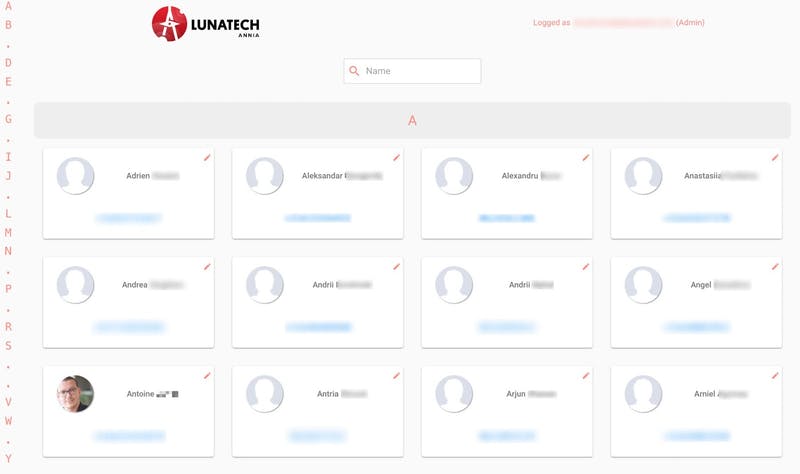
Figure 1: Phonebook feature
Technologies used in Annia
Annia is composed of two parts : a backend that exposes a REST API built with Kotlin and a web application designed with React.js.
For the backend, we chose Kotlin, a new and very promising language. Historically, Lunatech favors Java and Scala for projects. For that project, it was decided to experiment with Kotlin. In addition of Kotlin, we needed a framework to adapt it on the backend. I had the choice between three differents frameworks. As you can see, in the figure 2, we reduce the choice between Spring, Micronaut and Ktor. Micronaut was not chosen because it has a very small community and no documentation so very hard for me to learn how to use it. Ktor and Spring seems good but I prefer chose Ktor because it’s fully written in Kotlin and I think Ktor will become really good in the coming years.

Figure 2: Comparison between Spring, Micronaut and Ktor
Indeed, JetBrains support make the community growing each day as I saw on the Kotlin Slack (channel ktor).
For the frontend, we had the choice between Vue.js, Angular.js and React.js. Angular.js was put aside because I’ve already done a personal project using it, and I was eager to discover a new framework. Between Vue.js and React.js, the second was chosen. This decision was based on many recommendations, and the fact is that I was really not disappointed! Maybe, my next project will be in Vue.js to explore again a new way of thinking front application. We will have a look how the backend was built.
Global organisation of Annia
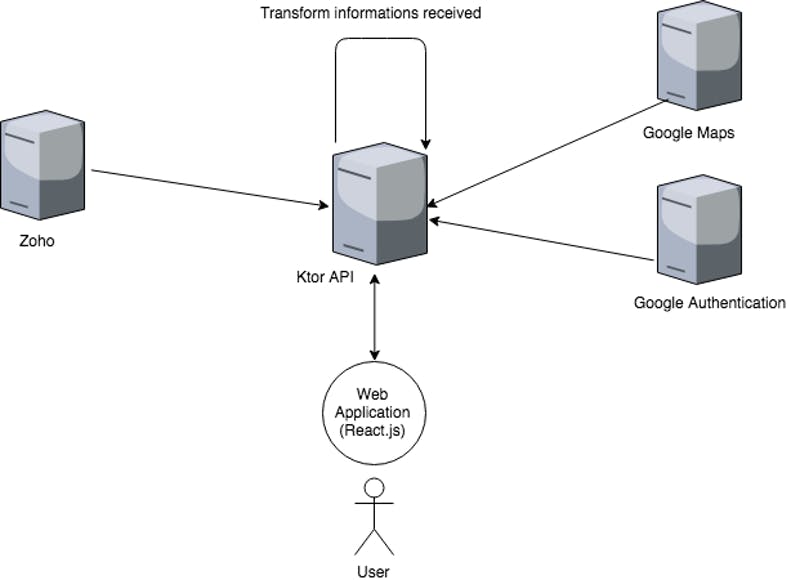
Figure 3: Global Architecture
The diagram above shows the general structure of Annia. The application interfaces with Zoho and to Google Maps by their APIs and we transform informations received for our use cases. Annia exposes 3 routes to interact with these APIs. First, a route to authenticate yourself through Google Authentication (only Lunatech employee are allowed). Another routes was set to interact with Zoho. You need to be authenticated to access all Zoho routes. You can interact with Zoho to retrieve all employees, to pick up one, or to update employee informations. Finally, we have a route pack to interact with Google Maps API. No authentication is needed to access these routes. You can choose a transit between two locations while specifying mode transport. It’s also possible to autofill an address and finally transform it by its tuple (latitude, longitude). As you can see in the figure 4, a swagger documentation exposes all routes availables for Annia and explain each one better than text above!
 Figure 4 : Annia swagger documentation
Figure 4 : Annia swagger documentation
The backend was not really complicated because we do not have a database. All the data are in Zoho so we transform informations to adapt it for our user cases. They are two users role, admin and regular user, they will be explain thereafter (fig 8 and 9). Let’s switch to the next part, we will explain first steps with Ktor and Kotlin.
Ktor and Kotlin in practice
When I start using Ktor, first impression given is a lack of documentation and some annoying bugs. However, after some days, the framework is handy. Many features were made to simplify development and tests. Moreover, you can count on a vibrant community to help you, Ktor’s developers are easily reachable on Slack in "#ktor public channel”.
In addition, Kotlin is a very good language when it comes to solve the null pointer exception in a smart way. Indeed (fig 5), in Java you need to check null very often to avoid the NullPointerException. We defined two variables. Name1 is String. This variable can’t be so this variable can be null. Name2 is String?null In first print, we are sure that name1 will not be null, so we can call it directly. In the second print, name2 can be null, so we use the Elvis operator ?:. Basically, the operator will take the right-value if something is null on the left-value, otherwise it will return the left-value. For the second print: The ? between name2 and length allow to check if the variable is not null. e.g if (name2 != null) name2.length else “null has no length”.
In last code line, that operation will not be possible and the IDE will show you an error since you tried to access length of a variable who can be null so you have to use the null safety operator? to avoid NullPointerException.
val name1: String = "Vincent"
var name2: String? = null
println("$name1 has length : ${name1.length}")
println("${name2 ?: "Null has no name"} ${name2?.length ?: "null has no length"}")
val tailleName2 = name2.length / /Not possible, an error will appearFigure 5: Example of handle Null
All convenient Kotlin features will not be explained but if you want to discover a new powerful language, it’s really worth it!
Ktor has a lot of useful tools too. If you want to discover all the potential of this framework, feel free to go to the official page. Take an exemple: with the feature ContentNegotiation you will be able to automatically convert a response or an answer to your DataClass according to Content-Type and Accept headers. If you call an API to receive an Employee, the feature will check if the header Content-Type` is equals to Employee. In the code below, the variable application/json and will automatically convert the response to your `DataClassmyDataClass will be directly convert to an Employee instance. Same mechanism apply for the response. On the last line code, you send your employee instance and it will be convert to the json corresponding without action from you. Easy way to handle json response and answer!
install(ContentNegotiation) {
gson {
disableHtmlEscaping()
}
}
val myDataClass = call.receive()
call.respond(MyDataClass("firstName", "lastName"))Figure 6: Example ContentNegotiation feature Ktor
Another important feature for a backend, is the routing. In figure 7, there is a route /employees to take all employees without authentication. In the route /employees/admin/update/{id} a handler will check if user got admin access and consecutively accept or not to go in the subsidiary route. Routing is really convenient with Ktor. We have many features to handle all user cases easily. For example, in the next version, you would like to have parameter id not required, just put ? after like {id?} and that’s done! I will not present all the routing features but it’s quite easy, and the learning curve is not really important.
route("/employees") {
get("") { ... } // get all employees
route("admin") {
intercept(ApplicationCallPipeline.Infrastructure) { ... } // verify admin privileges
put("/update/{id}") { ... } // update an employee
}
}Figure 7: Example routing using Ktor
Speaking about Kotlin and Ktor can take hours and I’ll need a lot of pages to describe all their benefits. Do not hesitate to take a look at the official Ktor website and official Kotlin website. If you want to see the swagger documentation for this API, you can access it by follow this link. In the next section, we will describe the web application designed with React.js.
Web application using React.js
You can access front application by following this link but you must be a Lunatech employee. As said above, I chose React.js for this part. As a matter of fact, React.js has a specific way to design the front-end based on the component concept. Main thing is that you can see React.js as a library and Angular.js as a framework. You are less constrained with React but also more is so broad in the options that you can spend lots of time picking a path. At this moment, choice is yours, depending on your goals. Personally I would rather use the “library way” because you can select the appropriate thing to work. Plus, the learning curve is not that steep… if you know HTML/CSS/JS. For CSS framework, I used Material-UI because it provides React components directly and there is no need to modify the css in most of the use cases.
The web application is simple (fig 10) In order, we have: Authentication page, Phone book page, Edit Page, See information Page, Search and autocomplete address Page and Transit time Page. (All interactions of the web application are with the API described above). The workflow is: you start by authenticate yourself with a Lunatech Google account.
At this point, you can see a list of all the employees. Depends of your role, as said above, you can see informations from Zoho about each employee. On this page, you can call an employee if you click on their phone number. To explain the difference between admin and other, look at figures 8 and 9.
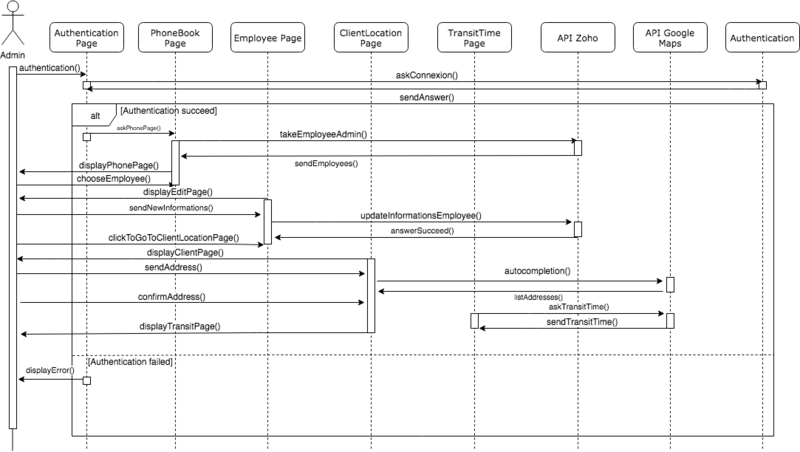
Figure 8: Sequence diagram Admin
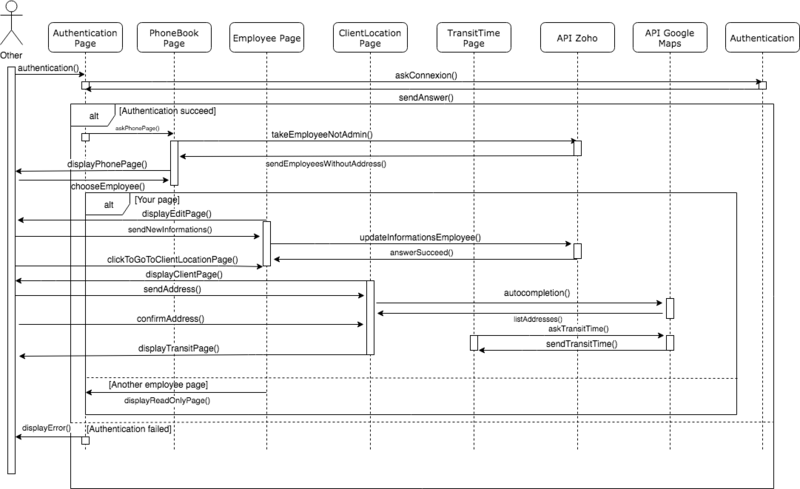 Figure 9: Sequence diagram Other
Figure 9: Sequence diagram Other
As said above, admin and other employee have not the same right. Their options are not the same for each call using Zoho API. An admin will be able to see all informations of each employee and update any of them. A regular user will be limited in some points. For example, this kind of user will not be allowed to see phone number of other employee if they don’t want to share it. Moreover, a not admin user will not receive the address of other employee and will be able to edit only his information.
If you click on your card, you can click on `Calculate transit time\`, and then, you will have to fill the client’s address (the address is automatically autofill).
Finally, transit time between your home and the client is release. You can click on the different icon representing the different transport mode to see on the map the most efficient route. Annia is fully responsive so you can use it with your mobile phone!
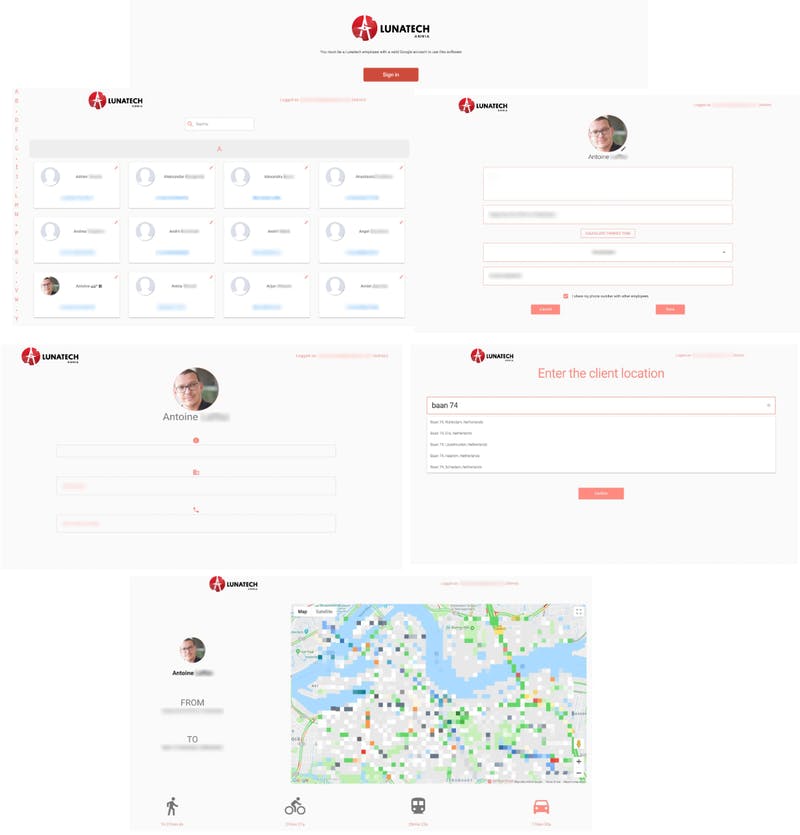 Figure 10: Screenshots Annia
Figure 10: Screenshots Annia
Conclusion
In conclusion, this project was a wonderful experience for me. It allows me to discover many unknown concepts and new languages. I want to thank Vincent Grente for his help in every steps of Annia and Lunatech in general for very interesting and kind people I met!
